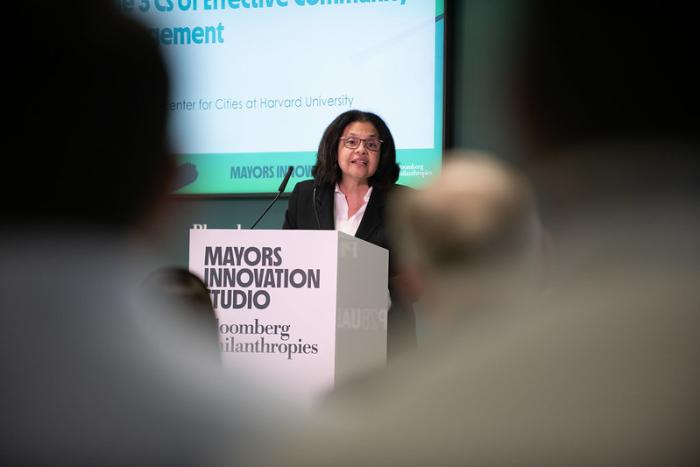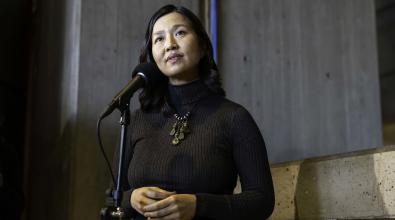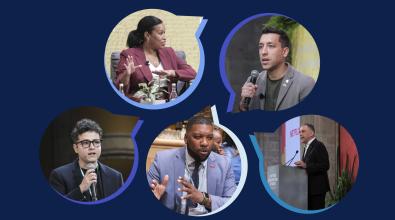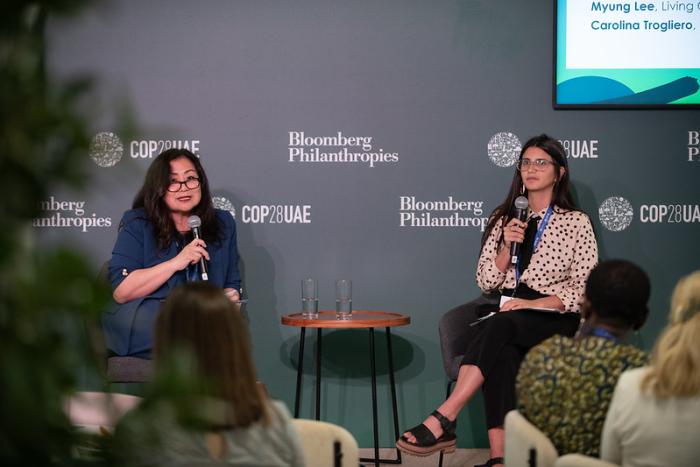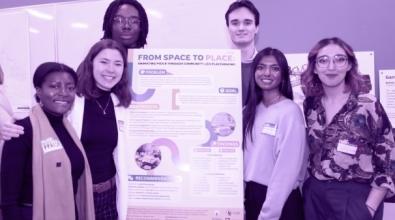 Read More
Read More
How city leaders can spur youth engagement on climate

Listen to This Article
Cities are leading the charge against climate change, just as they are on many global challenges. In fact, more than 1,000 of them have committed to cutting climate emissions by at least 50 percent within the next decade. At the same time, the world’s young people, about 60 percent of whom say they are “extremely” or “very” worried about climate change, are increasingly at the forefront of climate action. Understandably, many mayors are eager to combine these forces—local and youth action—to drive their climate efforts to new heights. But so far, cities are struggling to engage young people in this work meaningfully, and at scale.
That’s why more than 150 mayors came together last month at COP28 in Dubai for a Bloomberg Philanthropies-organized Mayors Innovation Studio that zeroed in on strategies to help cities better engage youth in local climate efforts—not just as beneficiaries or champions, but as co-creators and implementers of new, more ambitious solutions. The approaches surfaced build on the energy and urgency of the world’s youth—all 1.2 billion of them—and can serve as guides for next-level climate work in cities everywhere by breaking from the mold of top-down community engagement.
As Bloomberg Philanthropies CEO Patricia E. Harris put it when she addressed city leaders at the Mayors Innovation Studio, "With a little help… city leaders are taking action to improve public health and contribute to the climate fight, while also engaging residents to ensure the solutions last."
Double down on the benefits of civic engagement.
Before designing new plans with communities, leaders often can benefit from asking themselves four basic, yet essential questions around civic engagement: Why? What? Who? And how?
In the case of climate, that could begin with exploring why the city can benefit from engaging youth. One likely answer is that young people are uniquely eager and energized to work toward change. Another might be that they represent a largely untapped resource—a scarce commodity for most strapped local governments.
“Busy people often think civic engagement is going to just add endless meetings onto their calendars,” says Kimberlyn Leary, a senior fellow at the Bloomberg Center for Cities at Harvard and associate professor at the university, who led a session with mayors in Dubai. “It is true that people have to coordinate—and they have to meet. But well-designed civic engagement allows precious resources to be deployed with greater efficiency.”
Answering what and who can help scope possible engagements, uncover the best opportunities for young people to contribute, and might lead to strategies to engage people from diverse populations. Grappling with how will help city leaders zero in on tools and methods (including those spotlighted below) that can best activate youth.
Position young people as full partners—or co-designers—from the start.
City leaders are increasingly well-versed in the process of co-design, or proactively including residents on the very front end in conceiving of projects and policies. This will be an especially valuable tool as they engage young people in climate work, but it will require audience-specific calibration.
“'It’s an unrealistic expectation to ask people to change their personal habits and behaviors when, in their immediate environment, they're completely excluded from that process,” says Julia King, a policy fellow at LSE Cities and a design practitioner who strategized with mayors in Dubai.
Working with young people means meeting them where they are. That might include opening digital forums for discussions about climate—on Instagram or TikTok, for example—that invite and encourage youth feedback. Or it may involve shifting more traditional community engagement efforts—prototyping ideas at town-hall style meetings, for example—toward more youth-oriented events, such as hackathons, where they can share their best ideas for climate-change mitigation. Throughout, the process will benefit from an emphasis on creating space for people who are most affected by the problem—youth—to help craft a vision for what the new solution should be.
“I would argue that it is impossible to decarbonize if you don't take people with you on that process,” King says.
Let young people lead—or co-produce—on the delivery of solutions.
Just as young people are uniquely positioned to conceive of climate solutions by virtue of their long-term perspective and eagerness for new policies, they are as well positioned as any group of residents to actually enact the changes.
A promising—if small-scale—climate-specific example of this kind of co-production played out in Córdoba, Argentina. Mayor Martín Llaryora’s administration used a program called Jóvenes Innovadores, or Young Innovators, to invite 18- to 35-year-olds to propose solutions to local problems, offering $5,000 to help them with implementation of winning ideas. What one pair proposed—delivering streetlights to a neighborhood that lacked them by installing (and teaching residents to install) solar poles—resulted in 23 public lighting fixtures capable of producing light for more than 40 percent of the streets in that community.
“A lot of the time, I think young people—because they don't have all of the quote ‘expertise and experience’—have fresher ideas about how to go [about] approaching things,” says Myung Lee, chief strategy officer at Living Cities, who helped lead mayors in conversation in Dubai. “So they’re not going to think about the fact that there's no electricity being brought into that community as, like, ‘Oh my god, it’s a barrier.’ They're going to be like, ‘Alright, so what are we going to do to fix that?’”
Local leaders can start small: Lee suggests turning to local nonprofits to identify young people who might want to volunteer for the public good on a new climate initiative. There may be a local foundation that is willing to contribute because they're connected to young people or focused on climate issues, even if they aren’t already a close partner to their city.
“It's just facing the reality that you can't do it by yourself,” Lee says. “And here's another group of people that can help you.”
Create opportunities for co-governance.
Asking young people, who have the most to lose to climate inaction, to design and implement solutions is one thing. Bona fide co-governance with them around this issue is another matter entirely. Most cities are still working to make progress on this front—especially at the scale that the crisis demands. But there are hints of what these efforts could look like, including in cities such as Des Moines, Iowa, where high school and college students advise city leaders as part of a Youth Advisory Board, and Tirana, Albania, which mandates that 30 percent of city council members be under 35. Tirana also has established a youth environmental council, created by younger people to help shape strategic planning.
One simple way for city leaders to spark co-governance on climate is to create goals and guardrails to seek input from young people on implementation of programs and initiatives, even if they aren’t necessarily the final arbiters of every decision. Mayors might consider incorporating time for broaching climate-related decisions with young people into their daily or weekly schedules—or, if more realistic, the schedule of a member of their team—even if only a few minutes. Specific participants in those conversations could include representatives from a school’s student government or local youth political organizations. Already familiar tools like participatory budgeting—but with a youth focus—and climate-focused commissions with a mandate to involve young people can provide further launchpads for co-governance.
Harvard University’s Leary says that “as young people have recognized the power at their fingertips—literally, through social media, and increasingly with AI—they've come to understand that they can be actors and shapers of action, and that they may even be able to add certain skills and sensibilities that can augment the tools that elected and appointed officials have.”
While not every city is positioned to adopt an entirely collaborative approach to climate action, piecemeal or pilot efforts with these tools present them all an opportunity to integrate young people into citywide approaches to climate sustainability.
“It takes city leadership,” Leary says. “This is where the mayor comes in, to assert that doing things differently is a priority that's worth sustaining and investing in.”
